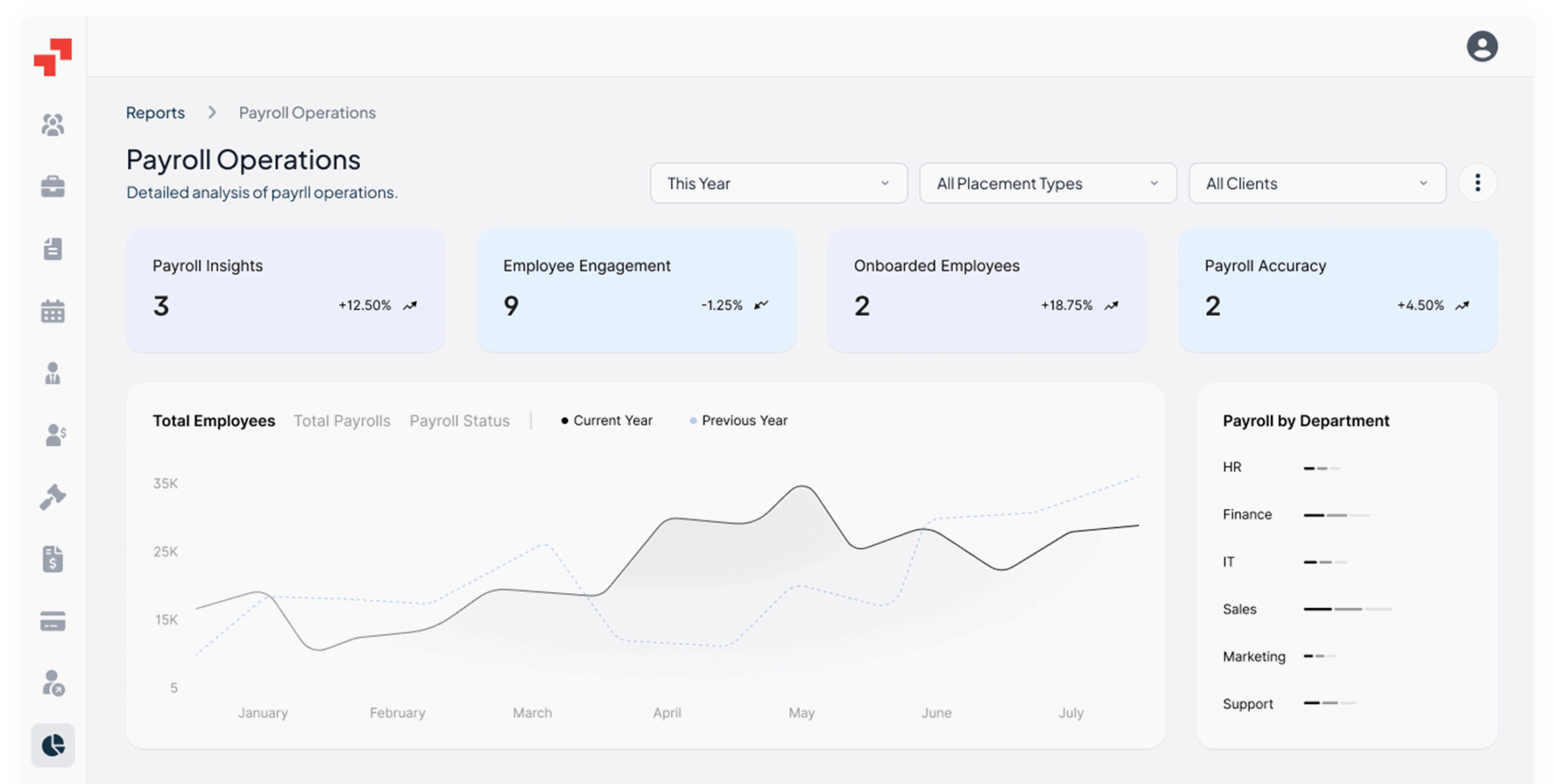Employee Cost Calculator - US [2025]
What is an Employee Cost Calculator USA?
The employee cost calculator USA is a powerful tool that helps employers estimate the true cost of hiring in any U.S. state. It goes beyond base salary to include the employee’s salary as well as all mandatory employer contributions such as Social Security, Medicare, FUTA, State Unemployment Insurance (SUI), workers’ compensation, and state disability or family leave insurance where applicable. The calculator ensures that all relevant annual costs are considered for a comprehensive expense calculation.
Whether you’re hiring a full-time employee in California or a contractor in Texas, this calculator provides a real-time, state-specific cost breakdown based on your selected pay frequency. Choose the state where your employee will be working—since the employee’s location directly affects the calculation due to varying taxes, social contributions, and benefits in each state. From payroll deductions to compliance costs, it simplifies complex American employment laws, giving you a clear picture of the cost of an employee calculator for your business.
Note: This tool can provide both annual costs and monthly estimates to help you plan your hiring budget accurately.
How to Use the True Cost of Employee Calculator? (Step-by-Step)
Using the employee cost calculator USA is quick and easy. Follow these steps to get an accurate estimate:
- Select the State – Choose the state where your employee will be working.
- Select Gross Pay Type – Choose Hourly, Daily, Monthly, or Yearly.
- Enter the Gross Pay – Input the salary or wage rate you plan to offer. You can enter an hourly rate and specify the hours worked to calculate labor cost accurately.
- Enter Your Details – Provide your Name, Phone Number, and Email Address to receive a personalized cost breakdown.
- Click Calculate – Get a detailed breakdown including:
- Monthly Gross Salary
- Social Security
- Medicare Tax
- FUTA Tax
- SUI Rate
- Family Leave Insurance (if applicable)
- Disability Insurance (if applicable)
- Workers’ Compensation Insurance
- EMAC (Massachusetts only)
- Total Employer Contribution
- Monthly Cost to Company (CTC)
- The ability to calculate labor cost based on hours worked and hourly rate
Note: This tool allows real-time estimates monthly or annually. Select your desired cycle and see instant results.
Overview of Employment Costs in the U.S. (2025–California Example)
Are you hiring in California or elsewhere in the U.S.? Here’s what you need to factor in beyond gross salary: Payroll taxes are calculated based on each employee’s wages, so accurate wage reporting is essential for compliance and timely payments.
| Cost Type | Amount (USD) | % of Gross Salary |
|---|---|---|
| Gross Salary | $5,000 | – |
| Social Security | $310.00 | 6.2% |
| Medicare | $72.50 | 1.45% |
| FUTA | $21.00 | 0.6% on the first $7,000/year |
| SUI (California avg.) | $238.00 | ~3.4% |
| CA Family Leave/Disability | $91.00 | ~1.3% |
| Workers’ Comp (IT industry) | $84.00 | ~1.2% |
| Total Employer Cost | $5,816.50 | ~16.3% extra |
Workers’ compensation rates depend on industry classification. Family leave and disability requirements vary by state.
Source: Sources:
U.S. Department of Labor ,
Internal Revenue Service (IRS)
California Employment Development Department , Updated for 2025.
To estimate annual costs, multiply the employee’s weekly hours by the weeks worked in a year and the hourly rate.
Breakdown of Employer Costs in the USA
- Social Security – 6.2% up to $176,100 wage cap
- Medicare – 1.45% of all wages, no cap
- FUTA – 0.6% after credit on first $7,000/year
- SUI – State-specific, 0.1% to over 5%
- Workers’ Compensation – Industry and state-based; average ~1.2%
- Disability & Paid Family Leave – Mandatory in CA, NY, NJ, MA
- Total Employer Liability: Employers generally pay an additional 12% to 20% of gross salary.
In addition to these main cost components, employers should also consider variable costs, such as recruiter time, employee location, and market conditions, which can fluctuate based on factors like employee turnover.
Understanding overall costs—including both fixed and variable costs—is essential for accurate budgeting and financial planning. Businesses can also calculate their labor cost percentage by dividing total annual payroll costs by total revenue, which helps assess the proportion of revenue dedicated to labor expenses and benchmark efficiency.
Sources:
Additional Costs to Consider:
Employers in the U.S. may also incur:
- Healthcare Benefits – $5,000–$7,500/year per employee, including health insurance premiums. The total number of employees directly impacts the per-employee cost, as total benefits costs are divided by the total number of employees.
- Paid Time Off (PTO) – Typically 10–20 days/year
- Recruitment & Turnover Costs – Use a cost of employee turnover calculator
- Training & Development – 1%–3% of payroll
- Equipment / Remote Setup Costs
- Office Space – Rent and related expenses for physical office locations are significant components of overhead costs.
Example: Employment Costs for a $7,000 Monthly Salary in California (2025)
Let’s say you’re hiring Jane as a new hire, a full-time software engineer in California:
| Cost Type | Amount (USD) | % of Gross Salary |
|---|---|---|
| Gross Salary | $7,000 | – |
| Social Security | $434.00 | 6.2% |
| Medicare | $101.50 | 1.45% |
| FUTA | $21.00 | ~0.3% |
| SUI | $238.00 | 3.4% |
| CA Paid Leave & Disability | $91.00 | 1.3% |
| Workers’ Comp (IT) | $84.00 | 1.2% |
| Total Employment Cost | $7,969.50 | ~13.85% |
Total cost to company: ~$7,970 per month, or ~13.85% above salary.
For similar roles and new hires, employers can expect total employment costs to be around 14% higher than the gross salary, depending on local regulations and industry standards.z
Employer Taxation in USA (2025)
| Tax Type | Details |
| Tax Year-End | December 31 |
| Payroll Taxes | Social Security, Medicare, FUTA, SUI |
| Corporate Income Tax | 21% federal + state (0–11%) |
| Local Payroll Levies | E.g., EMAC in MA, transit taxes |
How to Hire Employees in USA Without Setting Up a Local Entity?
Setting up a U.S. entity involves:
- Federal & state EIN registrations
- Multiple state tax accounts
- Payroll & benefits setup
- Litigation and compliance considerations
With PamGro’s Employer of Record (EOR) services, you can:
- Hire employees across Canada without opening a local entity
- Build and manage global teams efficiently, as EOR services simplify hiring and onboarding a new employee in any country
- Get complete payroll and compliance support
- Avoid CRA, WSIB, and provincial registrations
Cost Comparison: Setting Up an Entity vs. Using PamGro’s EOR
When expanding your business into a new country, understanding the cost implications of different hiring models is crucial. Setting up a local entity involves significant costs and administrative effort, including compliance with local regulations, registering with government authorities, and managing ongoing payroll and benefits administration. These steps can be both time-consuming and expensive, especially for companies new to the country’s legal and tax landscape.
In contrast, using an Employer of Record (EOR) service like PamGro offers a cost-effective and streamlined alternative. With PamGro’s EOR, businesses can hire employees in a new country without the need to establish a local entity, saving on setup costs and reducing compliance risks. The EOR manages global payroll, ensures adherence to local regulations, and provides a comprehensive benefits package to help you attract and retain top talent.
By choosing an EOR, companies can focus on growing their business and building their teams, while the complexities of payroll, benefits, and compliance are handled by experts. This approach not only reduces costs but also accelerates your ability to hire in new markets, making it an ideal solution for businesses seeking efficient, compliant, and cost-effective global expansion.
| Factor | Legal Entity | PamGro EOR |
| Setup Time | 4–8 weeks | 5–7 days |
| Registrations | Multiple states | None |
| Compliance Handling | In-house | Managed by PamGro |
| Legal & Admin Costs | High | Included |
PamGro EOR eliminates setup delays and compliance headaches. PamGro’s EOR simplifies hiring in the USA. Just onboard, set the salary, and we take care of the rest.
All-in-One Global Workforce Platform.
Manage global hiring, compliance, and payments with a single platform built for clients, contractors.
The Hidden Cost in Your US Hiring Budget—Is It Cause for Concern?
Employee Cost Calculator: Frequently Asked Questions (FAQs)
Ans. Social Security, Medicare, FUTA, state SUI, workers’ compensation, and sometimes disability/family leave
Ans: 0.6% on the first $7,000 per year after federal credits
Ans: State Unemployment Insurance; rates vary by state and employer experience (0.1%–6%)
Ans: Required in CA, NY, NJ, MA, etc., adding ~1% to 2% to total cost.
Ans: Employer Medical Assistance Contribution—state-specific levy applied to MA employers.
Ans: Use a cost of employee turnover calculator to quantify lost productivity, recruiting, and training expenses.
Ans: Yes. The cost of an employee calculator supports hourly, daily, monthly, and annual contractor pay modeling.
Ans: States have unique tax regimes—like CA’s disability insurance or NY’s paid family leave—affecting total cost.
Ans: On average, employers pay an additional 12%–20% over salary in combined federal and state costs.













